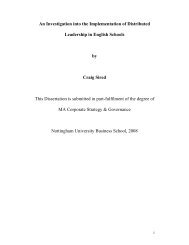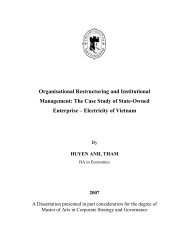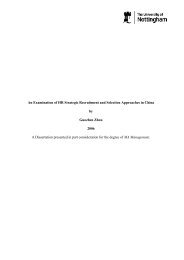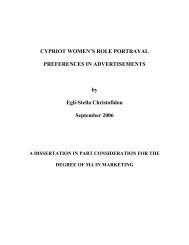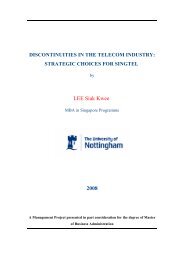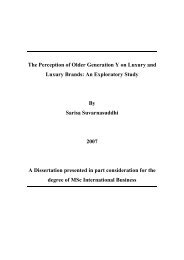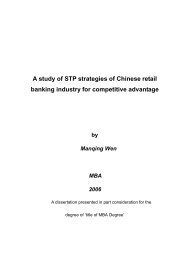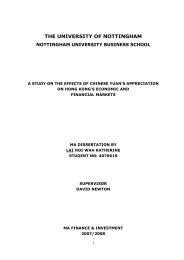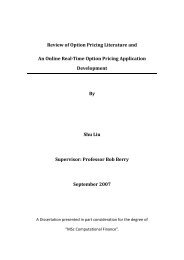application of real options valuation to r&d investments in ...
application of real options valuation to r&d investments in ...
application of real options valuation to r&d investments in ...
You also want an ePaper? Increase the reach of your titles
YUMPU automatically turns print PDFs into web optimized ePapers that Google loves.
approved.3.2 <strong>real</strong> <strong>options</strong> <strong>valuation</strong> <strong>in</strong> pharmaceutical <strong>in</strong>dustry3.2.1 IntroductionIn chapter two, <strong>real</strong> <strong>options</strong> <strong>valuation</strong> has been described, and the reason thattraditional DCF methods are not appropriate <strong>to</strong> evaluate R&D projects has also beenmentioned. Moreover, the f<strong>in</strong>ancial algorithms used <strong>to</strong> evaluate s<strong>to</strong>ck <strong>options</strong> havebeen exam<strong>in</strong>ed. Thus this session <strong>in</strong>tends <strong>to</strong> exam<strong>in</strong>e the scope <strong>of</strong> f<strong>in</strong>ancial algorithms,development for capital markets and their <strong>application</strong> <strong>to</strong> the e<strong>valuation</strong> <strong>of</strong> <strong>real</strong> <strong>options</strong>.The underly<strong>in</strong>g advantages and difficulties will also be discussed.The value <strong>of</strong> s<strong>to</strong>ck <strong>options</strong> can be determ<strong>in</strong>ed by us<strong>in</strong>g discrete time models like theb<strong>in</strong>omial method, where only two possible s<strong>to</strong>ck price changes are def<strong>in</strong>ed for each<strong>in</strong>terval. Or the cont<strong>in</strong>uous-time models accord<strong>in</strong>g <strong>to</strong> the Black-Scholes approach,which assumes that the s<strong>to</strong>ck price changes cont<strong>in</strong>uously. As the author specifies, thatboth methods are based on the assumption that option equivalents can be constructedcomb<strong>in</strong><strong>in</strong>g s<strong>to</strong>ck <strong>in</strong>vestment and borrow<strong>in</strong>g, where the cost <strong>of</strong> buy<strong>in</strong>g the optionequivalent is identical <strong>to</strong> the value <strong>of</strong> the option. The risk-neutral <strong>valuation</strong> approachcan be applied <strong>to</strong> transform the cash flows that are associated with the asset <strong>in</strong><strong>to</strong>risk-neutral cash flows, which can be then be discounted at the risk-free rate(Bode-Greuel, 2000).This is <strong>to</strong> say, when a <strong>real</strong> asset could be traded, the way <strong>to</strong> value f<strong>in</strong>ancial <strong>options</strong> onthe capital market would be identical for one <strong>to</strong> value this <strong>real</strong> asset, given that the<strong>real</strong> asset is sufficiently similar <strong>to</strong> its comparable asset. If so, managers will be able <strong>to</strong>use the advantages <strong>of</strong> option pric<strong>in</strong>g methods compared <strong>to</strong> other dynamic cash flowmethods such as decision analysis or dynamic DCF analysis.The ma<strong>in</strong> advantage <strong>of</strong> us<strong>in</strong>g the option pric<strong>in</strong>g methods is that decision makers canPage | 29



